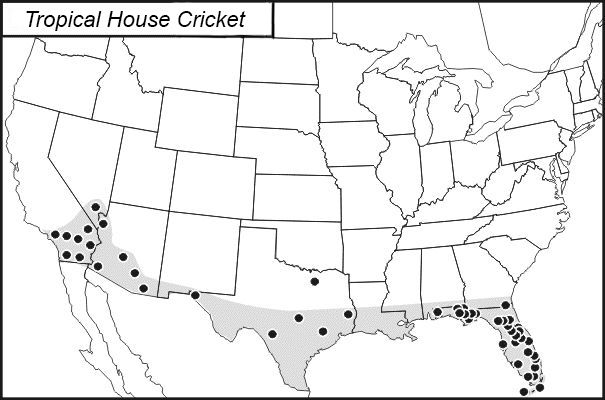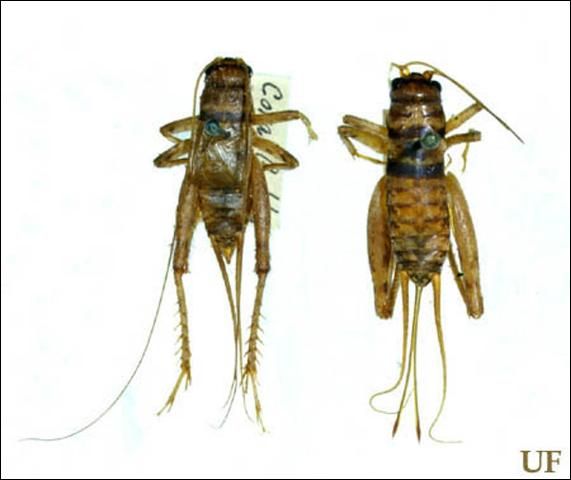The Featured Creatures collection provides in-depth profiles of insects, nematodes, arachnids and other organisms relevant to Florida. These profiles are intended for the use of interested laypersons with some knowledge of biology as well as academic audiences.
Introduction
The tropical house cricket, Gryllodes sigillatus, (also known as the "decorated cricket"), is common in urban areas and sometimes occur indoors. It is easily reared but, unlike its temperate counterpart (the house cricket), it is seldom exploited for pet food or fish bait.
Distribution
The tropical house cricket is probably native to southwestern Asia but has been spread by commerce to tropical regions throughout the world.

Life Cycle
Like house crickets, there is no special overwintering stage and generations are continuous. Depending on the temperature, development from egg to adult takes two to three months.
Identification
The tropical house cricket is a 13 to 18 mm long, light yellowish-brown, somewhat flattened cricket. Males have wings that only half cover the abdomen and females are practically wingless. Very rarely, a male or female has long wings that make them look like house crickets. However, in the tropical house cricket the space between the antennae is narrow (about the width of the basal segment of either antenna), and there is a single dark transverse band between the eyes.

Credit: Paul M. Choate, UF/IFAS
Habitat
In Florida, tropical house crickets are most frequently found outdoors in or near paved areas. At night they issue from hiding places, such as crevices between pavement blocks, to forage (like roaches) and sing (like crickets). When they move into buildings, as they occasionally do, their songs reveal their presence.
Song and Mating
The calling song (690 Kb wav file) consists of a sequence of brief chirps, each with three principal pulses. Within a chirp, each pulse represents a closure of the wings while a scraper on one wing engages a toothed file on the other. The pulses of a chirp grow successively longer as 1/2, 3/4 and the entire file is used (graphs). Only males call. When a female is attracted to the song, courtship ensues, and the male attaches a bag of sperm (spermatophore) to the female. The male surrounds the spermatophore with a proteinaceous mass on which the female feeds while the sperm pass into her internal sperm receptacle. The bigger the mass, the longer the sperm may have to enter, because the female usually eats all or part of the covering prior to removing the spermatophore proper.
Management
Generally tropical house crickets do no harm. Should they cause problems by their presence or calling in a structure, they can be eliminated by setting out baits sold for cockroach or earwig control.
Selected References
Ghouri ASK, McFarlane JE. 1958. Occurrence of a macropterous form of Gryllodes sigillatus (Walker) (Orthoptera: Gryllidae) in laboratory culture. Canadian Journal of Zoology 36: 837–838.
Rauf A, Aziz SA. 1983. Sound production in Gryllodes sigillatus. Journal of Entomological Research 6: 48–50.
Sakaluk SK. 1984. Male crickets (Gryllodes supplicans) feed females to ensure complete sperm transfer. Science 223: 609–610.
Sakaluk SK. 1987. Reproductive behaviour of the decorated cricket, Gryllodes supplicans (Orthoptera: Gryllidae): calling schedules, spatial distribution, and mating. Behaviour 100: 202–225.
Walker TJ. (2014). Tropical house cricket, Gryllodes sigillatus (F. Walker 1869). Singing Insects of North America. (11 April 2014).
Will MW, Sakaluk SK. 1994. Courtship feeding in decorated crickets: Is the spermatophylax a sham? Animal Behavior 48: 1309–1315.